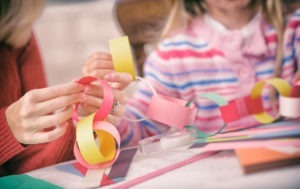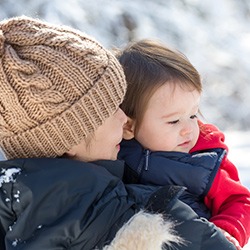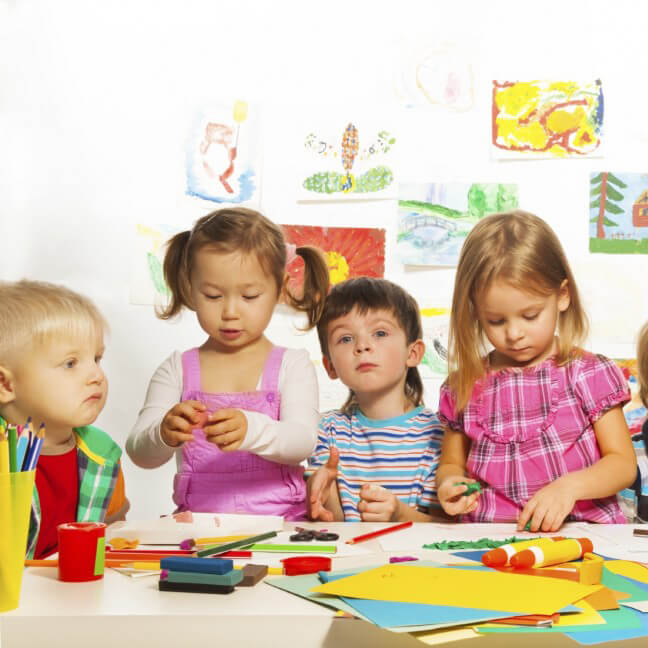Make a paper chain.

This classic, fine-motor-skill-boosting activity isn’t just for the holidays; it’s also an excellent way to count down to a birthday, an upcoming family trip, or another special event. Cut paper into strips about 1 inch by 5 inches, one strip for each day you want to count down. Show your child how to make paper chains by looping the paper strips around each other and gluing or taping the ends of each strip together. Hang the chain up in your home and use it to count down to an important event by removing the links, one day at a time.
Bundle up and enjoy the outdoors.
When the weather is cold, it can be tempting to pull on your comfiest socks and stay inside. But whenever you can, make time for outdoor activities that give your child’s motor skills a pick-me-up. Choose activities that involve both gross motor skills (throwing snowballs, sledding, climbing a snowy hill) and fine motor skills (putting a face on a snowman, collecting and sorting objects). Make a low ridge out of packed snow and leap over it together. Go on a neighborhood walk and play “I Spy.” Collect things like pinecones, acorns, and pretty stones in a pail, and help your child sort them into groups.
Create a winter-themed sculpture.

Not only are art projects a wonderful parent–child bonding experience, they also challenge young children to expand their problem-solving and motor skills. On a blustery day when it’s too cold to play outside, give your child a box of materials they can use as art supplies. You might include plastic bottles and containers, newspaper, pinecones, twigs, jar lids, cotton balls, paper plates, play dough, Popsicle sticks, colored paper, bits of ribbon and fabric, strong tape, paint, glitter, and glue. Work together to create a winter-themed sculpture, such as an “indoor snowman,” a penguin in a colorful scarf, or a tree covered with snow. When the sculpture is done, display it in a place of honor on the mantel or as a table centerpiece!
Make a map.
Kids love maps—and making one together is a great way to sharpen their skills. Partner up with your child to make a map of your neighborhood. Zip up your coats for a walk, take down notes or snap pictures of where the streets, buildings, parks, and other landmarks are, and then make the map using paper, scissors, labels, photos, and any other creative materials you have on hand. If you’d like to keep the project a little smaller, you can make a map of your house, beginning with your child’s room. Ask your child, “Where would we put your bed on the map? How about your toy box?”
Play a game with new toys.
Did your child receive some fun new toys as holiday gifts? Help them hone their problem-solving skills by playing games with their favorite treasures. Set five small toys in a “lineup” and  give your child time to look at the group. Then hide one of the toys and ask, “Which one is missing?” (You may have to give a few clues or hints at first.) Once your child guesses correctly, hide a different toy. Then give the child a turn to hide a toy and try to trick you!
give your child time to look at the group. Then hide one of the toys and ask, “Which one is missing?” (You may have to give a few clues or hints at first.) Once your child guesses correctly, hide a different toy. Then give the child a turn to hide a toy and try to trick you!
Toss some indoor snowballs.
Here’s a fun indoor winter activity that gives kids good practice with gross motor skills. Cut a few 8- to 9-inch holes in a big piece of cardboard and decorate the cardboard to look like a tree or a snowman. Give your child some “indoor snowballs” (beanbags or soft foam balls) and encourage your child to throw the snowballs through the holes on the target. Have your child start very close to the target and then move back a few feet to make it a little more challenging. Show your child how to throw both underhand and overhand, and be sure to cheer when the snowballs hit their target!
Carve out time for chats.
Make time at the end of the day to connect with your child. Talk about your day and what will happen tomorrow. Ask them simple questions about how their day went: “What was the best part?” “Were there any hard parts?” “How did you feel?” (You may need to give some gentle prompts to help them get started with the conversation.) Listen carefully to what your child says so they know their thoughts and emotions are important to you. Even if your child can’t answer all your questions yet, they’re listening and learning critical social-emotional skills. (For more social-emotional skill-boosters for children ages 2 months through 5 years, print these free ASQ:SE-2 activity sheets.)
Read together every night.
 On cold winter nights, snuggle up for some shared reading, one of the single most important activities you can do with a child. Not only is it an ideal way to bond and relax together after a busy day, it also strengthens your child’s communication and language skills and sets the stage for early literacy development. Choose some winter-themed books and engage your child while you read: ask them what happened at the beginning, middle, and end of the story, or have the child act out the story with you and pretend to be different characters.
On cold winter nights, snuggle up for some shared reading, one of the single most important activities you can do with a child. Not only is it an ideal way to bond and relax together after a busy day, it also strengthens your child’s communication and language skills and sets the stage for early literacy development. Choose some winter-themed books and engage your child while you read: ask them what happened at the beginning, middle, and end of the story, or have the child act out the story with you and pretend to be different characters.
Do a quick check of their milestones.
One of the most important things you can do this winter is check to see if your child’s overall developmental skills are on track in all the areas mentioned in this article. You can do that for free in about fifteen minutes or less. Fill out an online ASQ questionnaire to see what your child’s biggest strengths are, uncover new milestones to celebrate, and reveal any areas where your child may need extra support in the new year. (You can access the free research version of the questionnaire here.)
View and share this article as an infographic!





 give your child time to look at the group. Then hide one of the toys and ask, “Which one is missing?” (You may have to give a few clues or hints at first.) Once your child guesses correctly, hide a different toy. Then give the child a turn to hide a toy and try to trick you!
give your child time to look at the group. Then hide one of the toys and ask, “Which one is missing?” (You may have to give a few clues or hints at first.) Once your child guesses correctly, hide a different toy. Then give the child a turn to hide a toy and try to trick you! On cold winter nights, snuggle up for some shared reading, one of the single most important activities you can do with a child. Not only is it an ideal way to bond and relax together after a busy day, it also strengthens your child’s communication and language skills and sets the stage for early literacy development. Choose some winter-themed books and engage your child while you read: ask them what happened at the beginning, middle, and end of the story, or have the child act out the story with you and pretend to be different characters.
On cold winter nights, snuggle up for some shared reading, one of the single most important activities you can do with a child. Not only is it an ideal way to bond and relax together after a busy day, it also strengthens your child’s communication and language skills and sets the stage for early literacy development. Choose some winter-themed books and engage your child while you read: ask them what happened at the beginning, middle, and end of the story, or have the child act out the story with you and pretend to be different characters.